by Helen Grant
Memphis has an allure that is shrouded in food, music, and history. True it’s where Dr. King was assassinated, but it is also my birth city. Last year for my 32nd birthday, I took a trip to visit and better get to know the place I might have grown up in had my life circumstances been different.
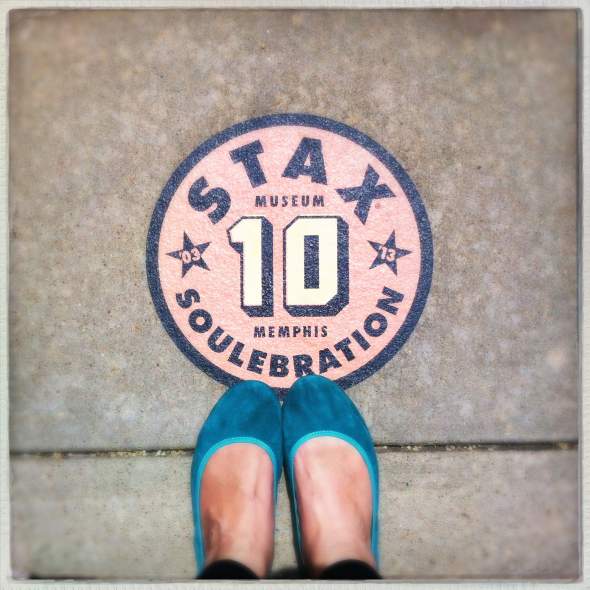
For me, in my aqua blue suede shoes, going back to Memphis was indeed a “Soulebration.” Also, I’m a big fan of portmanteaus.
Before someone scoffs that Memphis is a scary, crime-riddled cesspool, and that Oklahoma City and Tulsa are so awesome by comparison, let me just stop you right there. I happen to like Oklahoma City and Tulsa for different reasons. But you’ll need to check your bias if this is your reaction at the thought of visiting the Bluff City and feeling hypercritical about what it has to offer, because in some ways, it’s not so different from Oklahoma City or Tulsa, and in other ways it’s completely different.
Memphis may have been where Dr. Martin Luther King, Jr. was assassinated, but it is also the birthplace of rock and roll. The people there preserved much of its musical legacy, they celebrate music religiously from the annual Beale St. Music Festival to Goner Records annual indie block party Gonerfest, and it is, for better or worse, the site of the National Civil Rights Museum, to say nothing of the delicious BBQ situation, cute trolley system downtown, and the majestic Mississippi River.
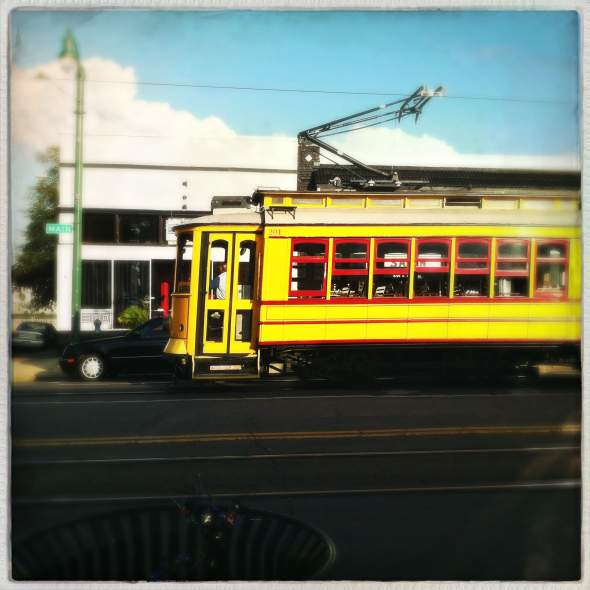
Dear OKC, please bring back trolleys.
So while there’s Graceland, which undoubtedly is what pops to most people’s minds, there’s also: Memphis Rock and Soul Museum, Sun Studios, Stax Museum of American Soul Music, and Stax Music Academy. By contrast, Oklahoma City paved over much of the Deep Deuce, to make room for a highway and new construction, although not all of it:
“Calvary Baptist Church, located on the National Historic Registry, is best known for turning away a preacher who wanted to become its pastor because he was too young. That preacher was Martin Luther King, Jr.â€
We do have places to visit in Oklahoma City other than the Oklahoma City National Memorial, and in the coming months I can see writing more about the Deep Deuce. But to this day, Tulsa still struggles with the legacy of its founding fathers, see the “sort of renaming†of the Brady Arts District, and its overall place in history when it comes to one of the worst race riots in U.S. history.
If I offended your Okie pride by being up front with the facts, please overcome it, and recognize that both Tennessee and Oklahoma made “The Most Dangerous States” list last year. Oklahoma was #10, while Tennessee was #1. The same social problems that make some parts of Memphis dangerous are the very problems that plague parts of Oklahoma City and Tulsa, namely poverty and lower numbers of adults with higher education as compared the national average.
Incidentally, ending poverty was an issue Dr. King championed in his collaborative Poor People’s Campaign. He was in Memphis working on this project, while supporting a strike. He realized that civil rights alone were not enough to make the overall quality of life better for African-Americans. Since poverty is color-blind, this evolved into a movement to end poverty for all. As he organized another march on Washington, he made trips to Memphis in 1968 to support the Memphis Sanitation Worker’s Strike. He was the figurehead of the Poor People’s Campaign until his assassination on April 4, 1968.
I believe that history has a way of influencing you even before you’re born; I mean how can it not? The confluence of events has to be such that your parents meet, and not only meet, but fall in love, and not only fall in love, but get married and decide to have you. The jobs they chose to have before you were born will of course shape your life too. My parents met in Memphis because they were in the military. They told me they’d frequent Overton Square on their dates in the late 70s to take in the jazz at The Bombay Bicycle Club. (Sadly, when I went back to explore Memphis, Overton Square wasn’t like they remembered it and had fallen into disrepair over the next couple of decades, although like OKC’s emerging arts and entertainment districts, it’s experiencing urban renewal.)
Eventually my mom got out of the Navy, and while my dad left the Marines and earned his first college degree, he did go back into the armed forces as an officer in the Army. Because of this, I’ve lived in a few Southern states (Alabama, Louisiana, Georgia, and Arkansas) and elsewhere in United States, like Hawaii, and outside too, think: Germany and Panama. Over that span of time and across countless borders I became especially cognizant of racism and economic disparity without ever having stepped foot back in Memphis; my parents left when I was infant.
I’m also not exactly what you’d call white-looking. If you want to debate that with me, as one misguided friend tried to suggest when comparing my interests to “stuff white people like,” which falls under the category of “shit white girls†say, let me just share that more than once in Oklahoma I have been asked if I’m my children’s nanny. Before you assume this was in a rural part of Oklahoma, no. It’s happened to me more than once in Norman, Moore, and Oklahoma City.  I get this question, or some variation, at least once or twice a year.
When I am with my family in a rural part of Oklahoma, we do get occasional stares from older folks. It’s not a quick glance either; it’s a long and puzzled look, as if their brains are playing the “one of these things is not like the other” game. Different sets of friends have been mistaken for my children’s parents when we go out for family meals; this is especially amusing for me when the server tries to give them the bill for my children. Naturally my friends are quick to point out the mistake.
But this is what you get when you’ve got European ancestors and you’ve basically accepted just how attracted you are to white men. You eventually end up married to a white guy and your combined recessive genes produce the ideal Aryan children: blond, fair, and light-eyed. Never mind that my oldest daughter, as I’m told by those who are paying attention, looks exactly like me.
Some people only see skin color.
I’m not bashing Oklahoma; honestly it is not the Deep South. I’ve lived in those places. And I learned later that Oklahoma City managed to avoid the kinds of widespread race riots that hit other major cities. But only seeing skin color is the mindset of many people everywhere.
So what about Memphis?
Not having the same skin tone as my children didn’t seem to be comment-worthy with the folks there during my 4-day sojourn.
Let me interject that last year I had been listening to a lot of Jim James’ “Regions of Light and Sound of God.” James channels some soul throughout the album and references Dr. King in one of his songs. Something about that album must have struck a chord, because I tangentially found myself researching more of King’s life. This isn’t to say I was completely ignorant of his life’s work, but I wasn’t as well-versed as I thought. This is how my music interests and family history tour landed us over in Civil Rights land. Although in retrospect, there is no way to soak in the city and not be confronted with that era of American history. Also music and the struggle for civil rights are two things that go hand-in-hand.
I also hadn’t realized how involved King had been in supporting the sanitation strike, as he made several trips to Memphis that Spring, before he was shot in front of his room at the Lorraine Motel that April.*
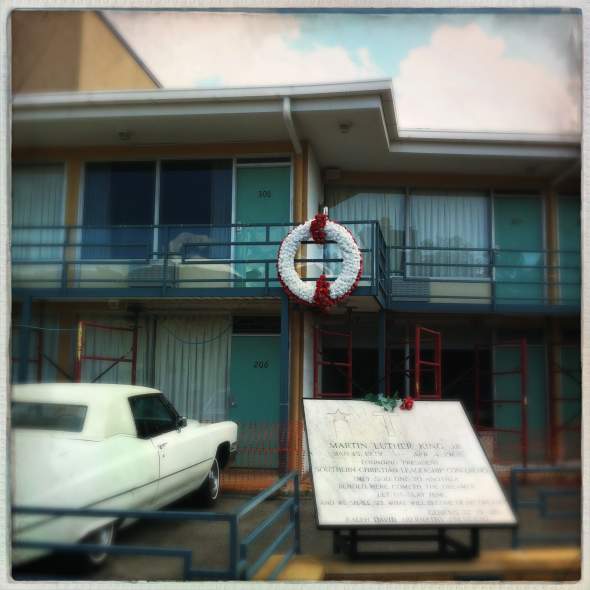
We couldn’t go inside because this section is under construction, but I’m told the room is exactly like it was in 1968.
I’m not going to lie. Planning that trip also scared me a little bit. I spent many a night in the lead-up cross-referencing crime reports and locations to pick a “safe” hotel, where to park, where to go, etc. Sometimes I wonder if the stats about OKC or Tulsa scare people the same way. While crime is going down, it does not match the dramatic decreases seen in other states.
I thought I had done so much research about my trip, but actually going there was a whole other story. I knew Memphis was poor, but I didn’t really get that there was serious poverty and blight until I arrived. In some areas it was much worse than what I’d seen driving around rundown parts of OKC.
This is where Jacqueline Smith comes into play.

Jacqueline Smith doesn’t waver, for the past 25 years she’s stayed on message about her opposition to the National Civil Rights Museum. You can talk to her about other things, but she won’t mix causes.
I wanted to visit the National Civil Rights Museum before I arrived, in addition to all the music museums my heart had been set on, what I didn’t know until the day I planned to visit the National Civil Rights Museum was that there is an on-going controversy that surrounds its existence. Which comes not from powerful business owners that are in the KKK (as one tends to assume, because what rational adult would be against a preserving an important beacon of history), but from disenfranchised African Americans, like Jacqueline Smith, and those who support her position.
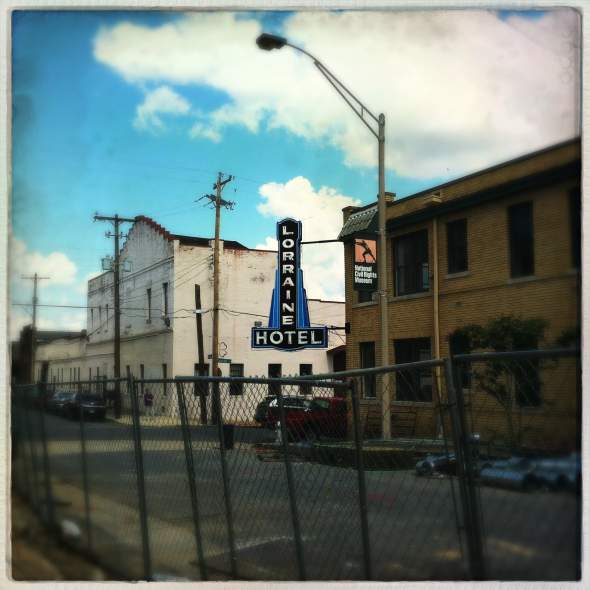
Smith, who has held vigil near the museum for over 25 years, doesn’t want to see the Lorraine Motel torn down, on the contrary, she wants to see the money being funneled into museum upgrades used to support projects closer to Dr. King’s dream. Her belief is rooted in Dr. King’s vision for ending poverty. So instead of the Lorraine Motel being turned into an empty mausoleum with paid admission and group tours, she rather the hotel portion be turned into a halfway house for people struggling with poverty and homelessness so they can get back on their feet. This would include getting assistance from job training programs in addition to other social services.
“King had an even more expansive vision. He laid out the case for the guaranteed income in his final book, 1967’s ‘Where Do We Go From Here: Chaos or Community?’ Washington’s previous efforts to fight poverty, he concluded, had been “piecemeal and pygmy.” The government believed it could lift up the poor by attacking the root causes of their impoverishment one by one—by providing better housing, better education, and better support for families. But these efforts had been too small and too disorganized. Moreover, he wrote, “the programs of the past all have another common failing—they are indirect. Each seeks to solve poverty by first solving something else.” – Jordan Weissmann, The Atlantic.
I want to tell you that I didn’t pay admission to see the National Civil Rights Museum after chatting with Jacqueline Smith about gentrification and how the museum got 2 million dollars in federal disaster funding, even though it wouldn’t provide evidence when asked to support its claim that the flood effected attendance, for the record: it wasn’t touched by the 2011 flood that damaged other parts of Shelby County.
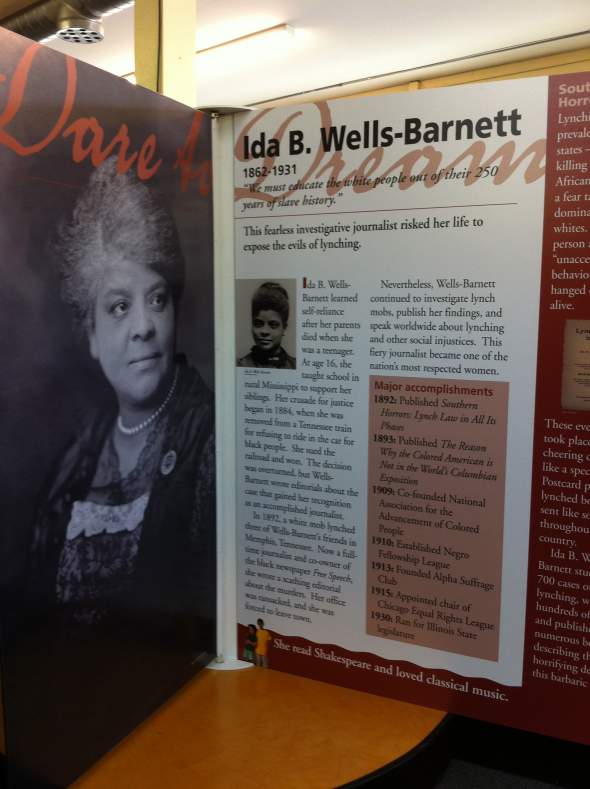
Still I had to see it for myself. I felt like I had to take in both sides before coming to a conclusion about the issue. At the time new construction on the Lorraine Motel was still underway, so I only visited the main wing of museum and a tangential “Freedom Sisters” wing related to Women of the Civil Rights Movement. The latter I found inspiring, but it lacked the stylish pizzazz of the main building. And it felt as if it were tacked on as an after thought, while an area in the main museum dedicated to various conspiracy theories and resulting investigations seemed convoluted and superfluous. The last section in the main museum, before you exit the obligatory gift shop, did focus on progress, education, and the future, so it wasn’t entirely a negative experience as it is often criticized by its detractors.

In the educational wing of the National Civil Rights Museum.
I can see both sides, because the National Civil Rights Museum is providing people with jobs, it does generate tourism, and it’s educational, but it could stand to take a cue from Stax Museum of American Soul Music. Stax not only is a door to the past, but for a few kids, mostly those ‘at-risk,’ it is a door to the future.
The thing I love most about Stax is that it keeps Memphis soul alive and burning in the next generation through its music academy, which is right next to the museum. When you think about it, it’s almost like it preserves the original spirit, considering that Stax’s record shop (Satellite Records), run by co-founder Estell Axton, functioned like a market testing ground for new music and fostered a creative space for young minds. Unlike some record shops at the time, all kids were allowed to come in and preview whole albums.

In the educational wing of the National Civil Rights Museum.
Alas, like Oklahoma City’s Academy of Contemporary Music, Stax Music Academy is a relatively new thing for Memphis, as it started in 2001 at a public school before moving to its current location.
When I walked through the National Civil Rights Museum, I felt it didn’t have that same kind of community spirit. It was more somber. And it didn’t seem to offer the surrounding community anything specific other than being a destination, which might bolster the neighborhood economy for independent shop owners, and it did have a few educational partnerships and grants. But it doesn’t seem like the sort thing that strives to focus on the legacy of King’s unfinished goals as much as the assassination and the resulting fall-out, which are important in a historical context – sure, but it’s not the same as investing in the community vs investing in new parts of the museum.
Actually, Stax was a bit of an anomaly since it really was the only museum I visited with a full-on educational academy.
As Think Progress notes in “Why Martin Luther King’s Dream is Still Unfinished,†those unmet goals are: 1) Making sure everyone has a living wage, 2) Desegregation, 3) Fair Voting, and 4) Unfettered Unionization.
Ultimately, when I came back from Memphis, I had a renewed appreciation for the direction Oklahoma City and Tulsa are moving towards, especially when it comes to the revitalization of run down neighborhoods. And of course discovering neighborhood improvement programs in OKC like Positively Paseo. This program essentially aims to beat back urban blight and crime by making housing affordable enough to draw families into the area to stabilize it and build a strong community. It’s not quite the opposite of gentrification, but it’s worked. From the Paseo, the program has moved into the Classen Ten Penn area.
Visiting Memphis and revisiting Dr. King’s legacy also reinforced what I already knew, which is that crime and poverty are not mysterious social woes we don’t know how to handle more intelligently. We do. All it takes is a committed majority. As King noted, you cannot have small, disorganized efforts aimed at solving one indirect problem at a time when what is really needed is to tackle a major problem directly. The quality of life, (public transportation, parks, things to-do, economic opportunity) and the condition of environment that surrounds us has a huge impact on our psyches and on the lives of people who must live in these places. These truths are self-evident.Â
It’s here I’ll leave off on a quote I found via The Atlantic article I referenced earlier:
“The contemporary tendency in our society is to base our distribution on scarcity, which has vanished, and to compress our abundance into the overfed mouths of the middle and upper classes until they gag with superfluity. If democracy is to have breadth of meaning, it is necessary to adjust this inequity. It is not only moral, but it is also intelligent. We are wasting and degrading human life by clinging to archaic thinking.
The curse of poverty has no justification in our age. It is socially as cruel and blind as the practice of cannibalism at the dawn of civilization, when men ate each other because they had not yet learned to take food from the soil or to consume the abundant animal life around them. The time has come for us to civilize ourselves by the total, direct and immediate abolition of poverty.” -Dr. Martin Luther King, Jr. “
(*Interesting side note for music lovers: the Lorraine Motel going out of business hindered Stax, there were other set backs, but the assassination introduced a new kind of tension that had not existed before. You see, Stax was one of the few studios where musicians were fully integrated. Sun Studios had some mixed-race collaborations, but at Stax people were like family, and the record store next door drew kids from all backgrounds. Outside Stax Studio integration wasn’t widespread. And the Lorraine Motel was one of the few places black and white musicians could mingle together in Memphis. After King’s assassination, however, all that changed.)